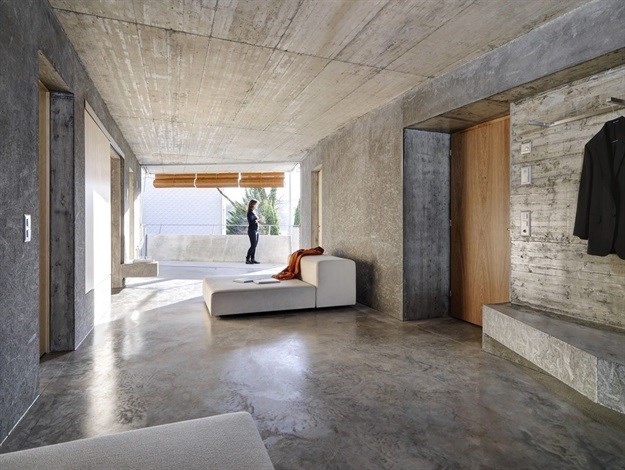Gus Wüstemann Architects completes concrete affordable housing in Zurich

Called Affordable Housing Langgrütstrasse, the overall form of the building is designed in the simplest way using concrete material and large and simple interior spaces. Commissioned by the Baechi Foundation, the foundation wanted the architects to build a housing block in Zurich with a high living quality on a low budget.
The building, accommodating nine flats, is located in the outer green belt of Albisrieden in the city of Zurich. The urban structure is characterised by simple linear buildings from the 1950s with generously sized gardens, which are arranged at right angles to one another. The new building is inside such a green area as part of the rising density within the city, a solitaire, in between the linear buildings.
"The Baechi Foundation specifically asked for affordable housing with a great quality of living in the centre of Zurich. Natural light, privacy and a spatial moment of generosity, were the focus of this project," said the architects in a project description.

Lively spaces
The project Langgrütstrasse 107 should prove that by targeting interventions in light and space and at the same time reducing common standards, great and lively spaces are possible. This without any additional economical effort.
"In today's world, it takes a rethink. Sustainability in the sense of less for the individual, but more for the community is becoming increasingly important. In architecture, here in housing construction, we show with this project how the shift of focus, away from connotations and standards to space, momentum and room quality, makes this possible," the architects added.
The block includes four two-bedroom apartments of 60m2 and five three-bedroom apartments of 95m2 each. For this block, the rents had to be affordable and so all the flats were rented out considerably cheap – the rent is amongst the cheapest in the city of Zurich.
Morphologically, the building is comprised of a solid concrete block, organically formed, from which two courtyards were cut out. In these courtyards the living spaces float like bridges, from the morning sun to the evening sun.
A continuous space that topographically creates the feeling that the living space is an exterior space and not an interior space filled up with a housing programme.

Magnitude in a small space
"This results in an incredible moment of magnitude in a small space. Hence there is a generous open living space – which can be enlarged to the periphery of the balconies and sheltered by the famous wooden persianas from Barcelona," added the firm.
By following the Swiss standards, the architects optimised interventions in an economic way by reducing all the technical installations of the building to a minimum.
"We focus on a couple of interventions that add major value to the quality of the living space. These are sliding windows and a built-in bench as the communicative element of the concrete topography," added the architects.
The periphery of the living space is topographically processed and makes the space-limiting elements communicative. Therefore, the building elements and especially the periphery of the space is not a parting wall, but a topographically shaped protagonist.

The bathroom of the three-bedroom flat is separated from the common area by a sliding door that does not touch the floor. It keeps the space floating as a common space, at the same time providing all the intimacy you need.
The entrance to each flat is guided by a condensed massive concrete beam that catches the moment of entry. The concrete bench growing out of the bathroom wall creates a common space just at the entry of the bath sliding door. The concrete floor floats in all the bedrooms, letting the common space flow and then inside the room a wooden floor implicates another level of intimacy.
Article originally published on World Architecture Community.